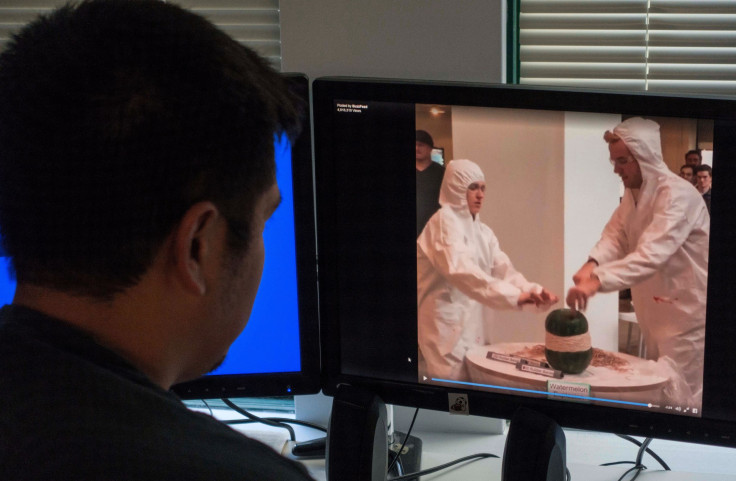Why BuzzFeed Exploding A Watermelon On Facebook Is Not The Future Of TV

The post-lunchtime hours on a Friday are typically a time when office denizens start looking for online distractions — something, anything, to occupy them until it's officially time to punch out. Last Friday, thousands of these people found exactly what they were looking for around 3 p.m. EDT as two BuzzFeed employees, on Facebook Live, exploded a watermelon by wrapping rubber bands around it.
It was the kind of audience that might set TV executives clutching their pearls: Nearly 2.8 million people accessed the stream during the afternoon doldrums (Eastern Time), with the number of concurrent viewers peaking at more than 800,000 at the moment the melon’s rind decided to call it a day, sending scads of pinkish flesh flying through the air.
While those numbers are not unimpressive, they don’t signal the end of traditional television as we know it.
Getting 2.8 million people to watch any one thing is not an easy task; getting 800,000 of them to watch something at the same time, particularly when it hasn’t been marketed to any of them by traditional means, is even more impressive. The watermelon experiment was timed perfectly and given just the right amount of social-media juicing to go viral. TV industry sources gave BuzzFeed kudos for being able to attract that kind of internet-shattering attention.
But they’re not exactly quaking in their boots yet. Sure, 800,000 people sounds like a larger audience than quite a few of cable’s original scripted series — but that’s an apples-to-melons comparison.
The TV ratings most people use come from media research juggernaut Nielsen, and the ones used in the press generally measure only the U.S. audience. The audience for Facebook Live, meanwhile, is global. Moreover, TV ratings are measured in an entirely different way, one that takes into account the entire duration of a telecast.
“Digital content creators typically use ‘views’ in regard to online streaming, or else they provide unduplicated reach,” says Glenn Enoch, senior vp of audience insights at Nielsen. “Television ratings, on the other hand, represent the viewing in the average minute, so comparing the two is not a true and fair look at the given audiences.”
So when Nielsen says 818,000 people watched FX’s airing of the feature film “Just Go With It” on March 28, from 8 to 10 p.m., that means each minute of that airing averaged 818,000 viewers in the U.S. (Nielsen has created a true apples-to-apples way of comparing global digital and traditional viewership that it's rolling out now.)
While we don't know the average viewers per minute for BuzzFeed's video, we can infer from this graph that it was lower than 800,000:
@alexweprin @brianstelter @corybe here's the stats pic.twitter.com/vdQO11b7sf
— Dorsey Shaw (@dorseyshaw) April 8, 2016
As with most viral social media moments, the BuzzFeed watermelon explosion came out of nowhere. The tweets and Facebook shares began dribbling into people’s feeds, and the number of concurrent viewers for BuzzFeed’s live stream grew astronomically (if not technically exponentially) in mere minutes, adding on hundreds of thousands of gawkers that could have come from anywhere in the world.
As of the publication of this story, around 70 hours after the live stream finished on Friday afternoon, BuzzFeed’s 45-minute video of the rubber-banding process has 9.9 million views. In order to count as a “view” on Facebook, all you have to do is see three seconds of a video that, more likely than not, has automatically begun playing as soon as the page is fully loaded.
BuzzFeed has 7-plus million-plus Facebook fans to alert to the fact that it’s going live; too, all 1.6 billion of Facebook’s active monthly users could have tuned in live, had they so desired (or been awake). So, said one cable TV executive, it wasn’t all that surprising that the internet juggernaut’s science experiment went over so well; the promise of an explosion, even if it's only a fruit, is catnip to all audiences.
The economics of a brand-new “broadcaster” like Facebook Live are still developing; There weren’t any ads interrupting the BuzzFeed stream, or any pre-roll interfering with viewers’ attempts to witness the moment of the explosion. The only apparent costs, though, were rubber bands, a watermelon and a couple of hazmat suits.
FX, meanwhile, may spend millions of dollars on a low-rated drama series like “Louie” (average live audience of 480,000 for its most recent season), but it also has more ways to recoup that investment than just the advertising sold during the show’s initial run. Sources say it’s unlikely other online video networks will fork over millions of dollars for the privilege of showing its users the BuzzFeed Watermelon Video, no matter how many “views” it gets. Streaming services, though, will do that for “Louie,” back seasons of which are available on Netflix, Amazon Prime and Hulu.
So no, TV execs aren’t gnashing their teeth over the fact that a Facebook Live stream drew such a large concurrent audience while their networks are spending tens of millions of dollars on low-rated series. As one source pointed out, they’ve been contending with low-production-value YouTube videos that have garnered millions of views for a decade, now. Same content, different service.
© Copyright IBTimes 2024. All rights reserved.






















